Definition, Properties, Derivation, Formulas, Solved Example Problems - Normal Distribution | 12th Business Maths and Statistics : Chapter 7 : Probability Distributions
Chapter: 12th Business Maths and Statistics : Chapter 7 : Probability Distributions
Normal Distribution
Distribution
The following are the two types of Theoretical distributions :
1. Discrete distribution 2. Continous distribution
Continuous distribtuion
The binomial and Poisson
distributions discussed in the previous chapters are the most useful
theoretical distributions for discrete variables. In order to have mathematical
distributions suitable for dealing with quantities whose magnitudes vary
continuously like weight, heights of individual, a continuous distribution is
needed. Normal distribution is one of the most widely used continuous
distribution.
Normal distribution is
the most important and powerful of all the distribution in statistics. It was
first introduced by De Moivre in 1733 in the development of probability.
Laplace (1749-1827) and Gauss (1827-1855) were also associated with the
development of Normal distribution.
NORMAL DITRIBUTION
Definition 7.3
A random variable X
is said to follow a normal distribution with parameters mean and variance σ2
, if its probability density function is given by

Normal distribution is
diagrammatically represented as follows :
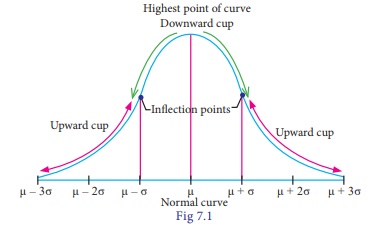
Normal distribution is a
limiting case of Binomial distribution under the following conditions:
(i)
n, the number of trials
is infinitely large, i.e. n → ∞
(ii)
neither p (or q)
is very small,
The normal distribution
of a variable when represented graphically, takes the shape of a symmetrical
curve, known as the Normal Curve. The curve is asymptotic to x-axis on its
either side.
Chief Characterisitics
or Properties of Normal Probabilty distribution and Normal probability Curve .
The normal probability
curve with mean μ and standard deviation σ has the following properties:
(i) the curve is bell-
shaped and symmetrical about the line x=u
(ii) Mean, median and
mode of the distribution coincide.
(iii)
x –
axis is an asymptote to the curve. ( tails of the cuve never touches the horizontal
(x) axis)
(iv) No portion of the
curve lies below the x-axis as f (x) being the probability
function can never be negative.
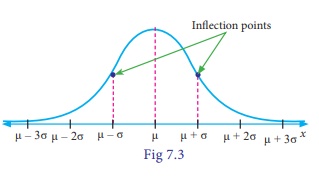
(v) The Points of inflexion of the curve are x = ± µ σ
(vi) The curve of
a normal distribution has a single peak i.e it is a unimodal.
(vii) As x increases
numerically, f (x) decreases rapidly, the maximum probability
occurring at the point x = μ and is given by [p(x)]max = 1
/ σ √2π
(viii) The total area
under the normal curve is equal to unity and the percentage distribution of
area under the normal curve is given below
(a) About 68.27% of the
area falls between μ – σ and μ + σ
P(μ – σ < X <
μ + σ) = 0.6826
(b) About 95.5% of the
area falls between μ – 2σ and μ + 2σ
P(μ – 2σ < X <
μ + 2σ) = 0.9544
(c) About 99.7% of the
area falls between μ – 3σ and μ + 3σ
P(μ – 3σ < X <
μ + 3σ) = 0.9973
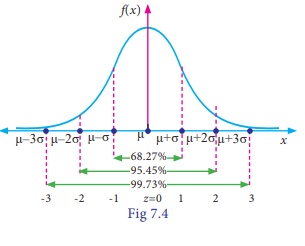
STANDARD NORMAL DISTRIBUTION
A random variable Z =
(X–μ)/σ follows the standard normal distribution. Z is called the standard
normal variate with mean 0 and standard deviation 1 i.e Z ~ N(0,1). Its
Probability density function is given by :

1. The area under the
standard normal curve is equal to 1.
2. 68.26% of the area
under the standard normal curve lies between z = –1 and Z =1
95.44% of the area lies
between Z = –2 and Z = 2
99.74% of the area lies
between Z = –3 and Z = 3
Example
7.21
What is the probability
that a standard normal variate Z will be
(i) greater than 1.09
(ii) less than -1.65
(iii) lying between
-1.00 and 1.96
(iv) lying between 1.25
and 2.75
Solution :
(i) greater than 1.09
The total area under the
curve is equal to 1 , so that the total area to the right Z = 0 is 0.5 (since
the curve is symmetrical). The area between Z = 0 and 1.09 (from tables) is
0.3621
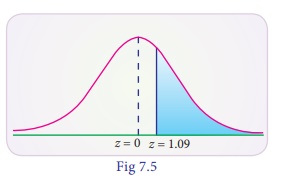
P(Z > 1.09) = 0.5000
- 0.3621 = 0.1379
The shaded area to the
right of Z = 1.09 is the probability that Z will be greater than 1.09
(ii) less than –1.65
The area between -1.65
and 0 is the same as area between 0 and 1.65. In the table the area between
zero and 1.65 is 0.4505 (from the table). Since the area to the left of zero is
0.5 , P(Z< 1.65) = 0.5000 – 0.4505 = 0.0495.
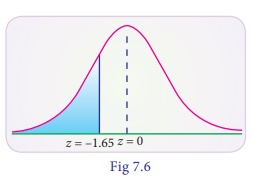
(iii) lying between
-1.00 and 1.96
The probability that the
random variable Z in between -1.00 and 1.96 is found by adding the
corresponding areas :
Area between -1.00 and
1.96 = area between (-1.00 and 0) + area betwn (0 and 1.96)
P(–1.00 < Z <
1.96) = P(–1.00 < Z < 0) + P(0 < Z < 1.96) = 0.3413 + 0.4750 (by
tables)
= 0.8163
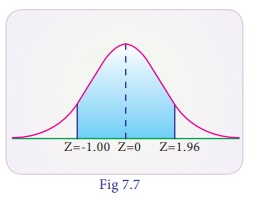
(iv) lying between 1.25
and 2.75
Area between Z = 1.25
and 2.75 = area betwn (z = 0 and z = 2.75) – area betwn (z=0 and z = 1.25)
P(1.25 < Z < 2.75)
= P(0 < Z < 2.75) – P(0 < Z < 1.25)
= 0.4970 - 0.3944 = 0.1026
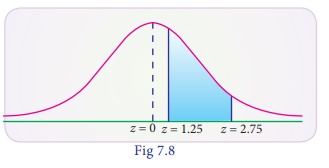
Example
7.22
If X is a normal
variate with mean 30 and SD 5. Find the probabilities that (i) 26 ≤ X ≤ 40 (ii) X >
45
Solution :
Here mean μ= 30 and standard
deviation σ = 5
(i) When X = 26 Z = ( X
− µ ) / σ = (26 – 30)/5 = –0.8
And when X = 40 , Z = [40
– 30] /5 = 2
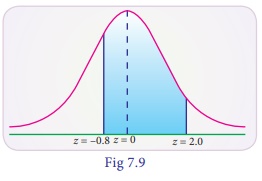
Therefore,
P(26<X<40) ) =
P(–0.8 ≤ Z < 2)
= P(–0.8 ≤ Z ≤ 0) + p(0
≤ Z ≤ 2)
= P(0 ≤ Z ≤ 0.8) + P(0 ≤
Z ≤ 2)
= 0.2881 + 0.4772 (By
tables)
= 0.7653
(ii) The probability
that X≥45
When X = 45
Z = [X − µ] / σ = [45 –
30] / 5 = 3
=P( X ≥ 45) = P(Z ≥ 3)
= 0.5 – 0.49865
= 0.00135
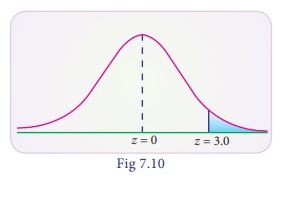
Example
7.23
The average daily sale
of 550 branch offices was Rs.150 thousand and standard deviation is Rs. 15
thousand. Assuming the distribution to be normal, indicate how many branches
have sales between
(i)₹ 1,25,000 and ₹ 1, 45, 000
(i) ₹ 1,40,000 and ₹ 1,60,000
Solution :
Given that mean μ= 150
and standard deviation σ= 15
(i) when X = 125
thousand
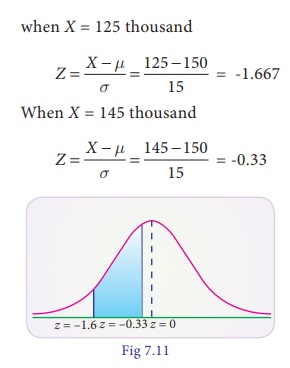
Area between Z = 0 and Z
= -1.67 is 0.4525
Area between Z = 0 and Z
= -0.33 is 0.1293
P(–1.667 ≤ Z ≤ –0.33) =
0.4525 – 0.1293
= 0.3232
Therefore the number of
branches having sales between 125 thousand and 145 thousand is 550 × 0.3232 =
178
(ii) When X = 140
thousand
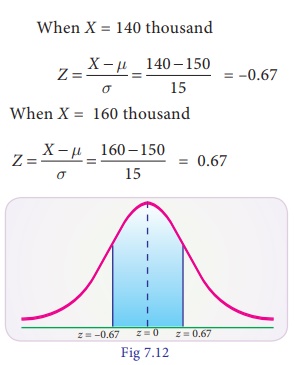
P(–0.67 < Z <
0.67) = P(–0.67 < Z < 0) + P(0 < Z < 0.67)
= P(0 < Z < 0.67)
+ P(0 < Z < 0.67)
= 2 P(0 < Z < <
0.67)
= 2 × 0.2486
= 0.4972
Therefore, the number of branches having sales between Rs.140 thousand and Rs.160 thousand = 550 × 0.4972 = 273
Example
7.24
Assume the mean height
of children to be 69.25 cm with a variance of 10.8 cm. How many children in a
school of 1,200 would you expect to be over 74 cm tall?
Solution :
Let the distribution of
heights be normally distributed with mean mean 68.22 and standard deviation =
3.286
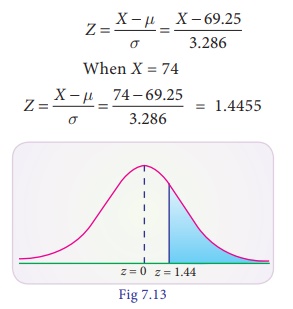
Now P(Z > 74) = P(Z
> 1.44)
= 0.5 – 0.4251
= 0.0749
Expected number of
children to be over 74 cm out of 1200 children
= 1200 × 0.0749 ≈ 90 children
Example
7.25
The marks obtained in a
certain exam follow normal distribution with mean 45 and SD 10. If 1,300
students appeared at the examination, calculate the number of students scoring
(i) less than 35 marks and (ii) more than 65 marks.
Solution :
Let X be the normal
variate showing the score of the candidate with mean 45 and standard deviation
10.
(i) less than 35 marks
When X = 35
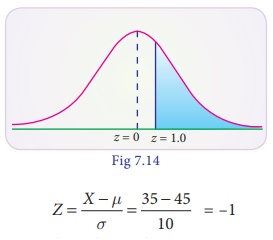
P(X < 35) = P(Z <
–1)
P(Z > 1) = 0.5 – P(0
< Z < 1)
= 0.5 – 0.3413
= 0.1587
Expected number of
students scoring less than 35 marks are 0.1587 × 1300
= 206
(ii) more than 65 marks
When X = 65

P(X > 65) = P(Z >
2.0)
= 0.5 – P(0 < Z <
2.0)
= 0.5 – 0.4772
= 0.0228
Expected number of
students scoring more than 65 marks are 0.0228 x 1300
= 30
Example
7.26
900 light bulbs with a
mean life of 125 days are installed in a new factory. Their length of life is
normally distributed with a standard deviation of 18 days. What is the expected
number of bulbs expire in less than 95 days?
Solution :
Let X be the normal
variate of life of light bulbs with mean 125 and standard deviation 18.
(i) less than 95 days
When X = 95
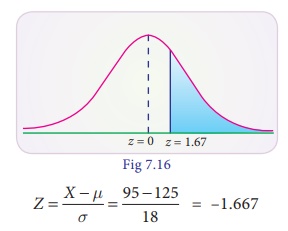
P(X < 95) = P(Z <
–1.667)
= P(Z > 1.667)
= 0.5 – P(0 < Z <
1.67)
= 0.5 – 0.4525
= 0.0475
No. of bulbs expected to
expire in less than 95 days out of 900 bulbs
900 × .0475 = 43 bulbs
Example
7.27
Assume that the mean
height of soldiers is 69.25 inches with a variance of 9.8 inches. How many
soldiers in a regiment of 6,000 would you expect to be over 6 feet tall?
Solution :
Let X be the height of
soldiers follows normal distribution with mean 69.25 inches and standard
deviation 3.13. then the soldiers over 6 feet tall (6ft × 12= 72 inches)
The standard normal
variate
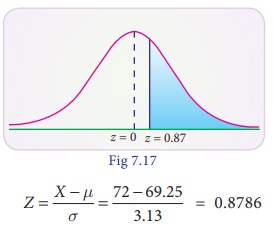
P(X > 72) = P(Z >
0.8786) = 0.5 – P(0 < Z < 0.88) = 0.5 – 0.3106 = 0.1894
Number of soldiers
expected to be over 6 feet tall in 6000 are
6000 × 0.1894 =1136
Example
7.28
A bank manager has
observed that the length of time the customers have to wait for being attended
by the teller is normally distributed with mean time of 5 minutes and standard
deviation of 0.6 minutes. Find the probability that a customer has to wait
(i) for less than 6
minutes
(ii) between 3.5 and 6.5
minutes
Solution :
Let X be the waiting
time of a customer in the queue and it is normally distributed with mean 5 and
SD 0.7.
(i) for less than 6
minutes
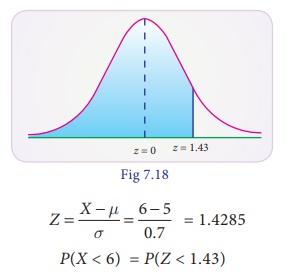
= 0.5 + 0.4236
= 0.9236
(ii) between 3.5 and 6.5
minutes
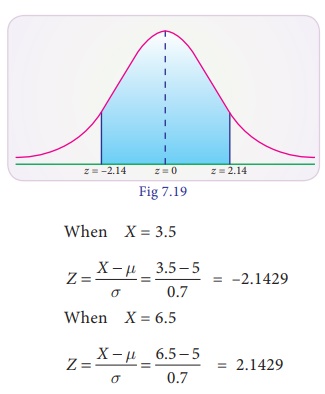
P(3.5 < X < 6.5)
= P (–2.1429 < Z < 2.1429)
= P(0 < Z <
2.1429) + P(0 < Z < 2.1429)
= 2 P(0 < Z <
2.1429)
= 2 × .4838
= 0.9676
Example
7.29
A sample of 125 dry
battery cells tested to find the length of life produced the following resultd
with mean 12 and sd 3 hours. Assuming that the data to be normal distributed ,
what percentage of battery cells are expected to have life
(i) more than 13 hours
(ii) less than 5 hours
(iii) between 9 and 14
hours
Solution :
Let X denote the length
of life of dry battery cells follows normal distribution with mean 12 and sd 3
hours
(i) more than 13 hours
P(X > 13)
When X = 13

P(X > 13) =
P(Z>0.333) = 0.5 – 0.1293 = 0.3707
The expected battery
cells life to have more than 13 hours is
125 × 0.3707 =46.34%
(ii) less than 5 hours
P(X < 5)
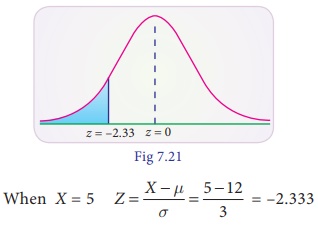
P(X < 5) = P(Z <
–2.333) = P(Z > 2.333)
= 0.5 – 0.4901 = 0.0099
The expected battery
cells life to have more than 13 hours is 125 × 0.0099 =1.23%
(iii) between 9 and 14
hours
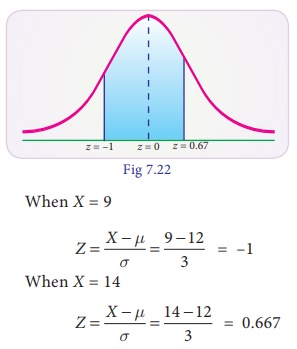
P(9 < X < 14) =
P(–1 < Z < 0.667)
= P(0 < Z < 1) +
P(0 < Z < 0.667)
= 0.3413 + 0.2486
= 0.5899
The expected battery
cells life to have more than 13 hours is 125 x 0.5899 =73.73%
Example
7.30
Weights of fish caught
by a traveler are approximately normally distributed with a mean weight of 2.25
kg and a standard deviation of 0.25 kg. What percentage of fish weigh less than
2 kg?
Solution :
We are given mean μ =
2.25 and standard deviation σ = 0.25. Probability that weight of fish is less
than 2 kg is P(X < 2.0)
When x = 20
Z = [X − µ] / σ = [2.0 − 2.25] / 0.25 = P(Z< -1.0) = P(Z
> 1.0)
0.5 – 0.3413 = 0.1587
Therefore 15.87% of
fishes weigh less than 2 kg.
Example
7.31
The average daily
procurement of milk by village society in 800 litres with a standard deviation
of 100 litres. Find out proportion of societies procuring milk between 800
litres to 1000 litres per day.
Solution :
We are given mean μ =
800 and standard deviation σ = 100 . Probability that the procurement of milk
between 800 litres to 1000 litres per day is
P(800 < X < 1000)

P(0 < Z < 2) =
0.4772 (table value)
Therefore 47.75 percent
of societies procure milk between 800 litres to 1000 litres per day.
Related Topics